While attending the National Surfing Championships in Port Isabel, Texas, Vicki Vickers at age 14 overheard Dogtown skater, Nathan Pratt declare that “Girls Can’t Skate.” At age 18, in her Who’s Hot!” article within the December 1978 issue of Skateboarder she told Jim Goodrich that she took Pratt’s comment seriously and immediately started skateboarding! Vickers would continue to be a vocal advocate for equal pay and support for women skateboarders throughout her career.

Vickers was originally from Pensacola, Florida but over the years moved between Texas and then eventually to Los Angeles. With inspiration from like the likes of Laura Thornhill and Ellen Oneal in the magazines, Vicki made progress skating Freestyle, but admitted she preferred riding reservoirs since it was the most fun (Goodrich 1979).
Vicki began to get noticed as a competitive skateboarder starting at a contest in Dallas, Texas hosted by Donel Distributors for Muscular Dystrophy on October 31, 1976. Vickers won the Girls Freestyle, and placed 2nd in the Slalom and in the Downhill. Her Texas sponsors were Skateboard City, V.J. Surf Shop, and Donel. She was easily the best female skateboarder in Texas at the time.
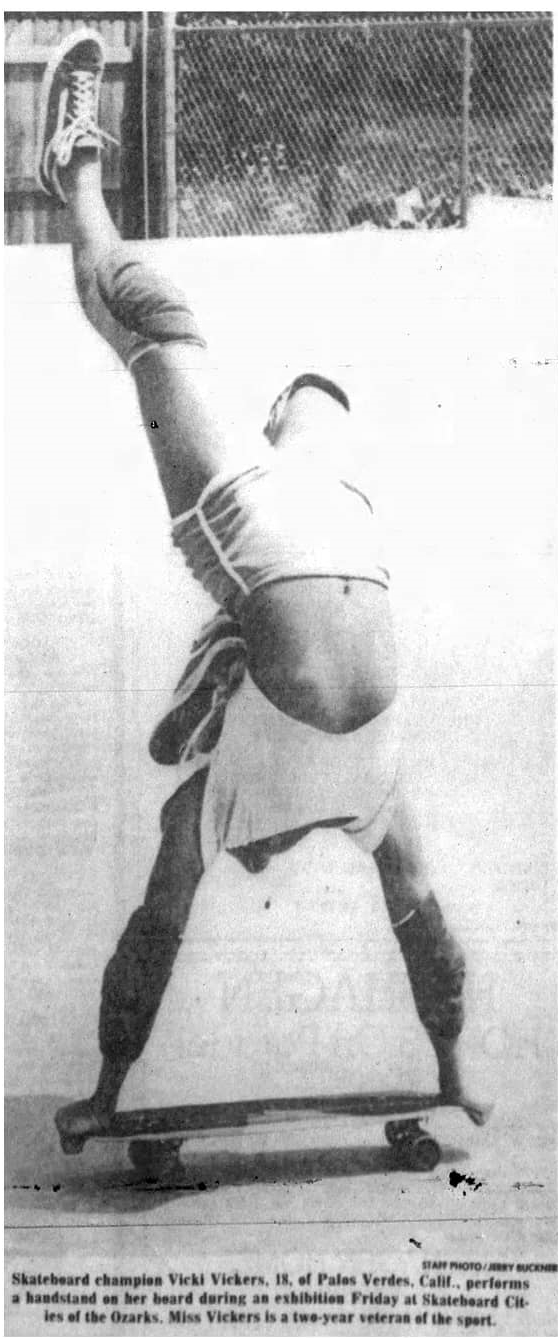

At the Kona Skatepark in Jacksonville, Florida the 1st Annual 7-Eleven Pro-Am contest was held on September 1977 and Vicki placed second behind Elaine Cherault in the Freestyle contest. In the May 1978 issue of the National Skateboard Review, Vickers is listed as being sponsored by Sims and riding for Paramount skatepark. She placed first in Sr. Women 18-26 for Freestyle and 3rd in Slalom at the Hang-Ten Olympics in April of 1978 at Magic Mountain.

Photo: Glenn Miyoda
While Freestyle was her starting point, Vicki moved into the terrain of pools and bowl-riding and slowly started to receive some press, including the special Women’s Section of the June 1978 issue of the National Skateboard Review. Vicki had a full-page feature which stated, “Vicki Vickers, now a Hobie team rider, has been working a long time with her skating. Previously from Texas, she was an independent rider for awhile. She participated in contests from Florida to Texas and back again. And it paid off… A good rider, as you can see by this move in the pipe [at] Pipeline skatepark, she’s even getting better after working out with a team.”



When Vicki moved to Los Angeles she found sponsorship with Pepsi, Kryptonics, and briefly with Alva. Vicki even rode the Pepsi plexi-glass halfpipe during the Rose Bowl Parade, which was covered in decorations for the occasion. Pepsi also took her on tour to Mexico, where she made a great impression and inspired local skater Stephanie Fernandez! Vicki graced the cover of the first Mexican skateboard magazine called Roller for the very first issue launched January 1979.


At Vicki’s first major California contest in May 1978 at the Newark Hester-ISA Pro Bowl event, she had the unfortunate experience of getting injured and was unable to compete. Di Dootson reported how Vicki had doubled up with Leilani Kiyabu but in their practice the two new pro skaters both came down from the lip simultaneously and collided in the bottom. Vicki shared that, “it was really pretty depressing. I thought I had that contest wrapped… Then me and Lani (Kiyabu) decided we’d be the first girls to ever do doubles… We were the first girls to both go into the hospital for 9 days!” (Goodrich 1979).
Fortunately, Vicki rebounded quickly, and at the I.S.A Northern California Pro Park Competition in August 1978 at Winchester she placed second behind Terry Lawrence in bowl riding.
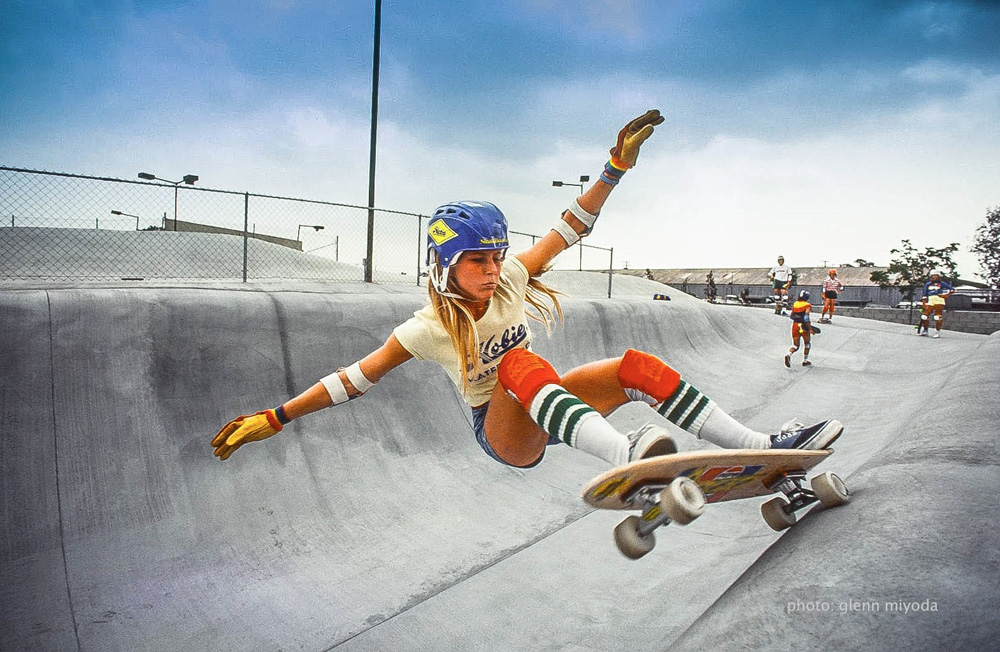


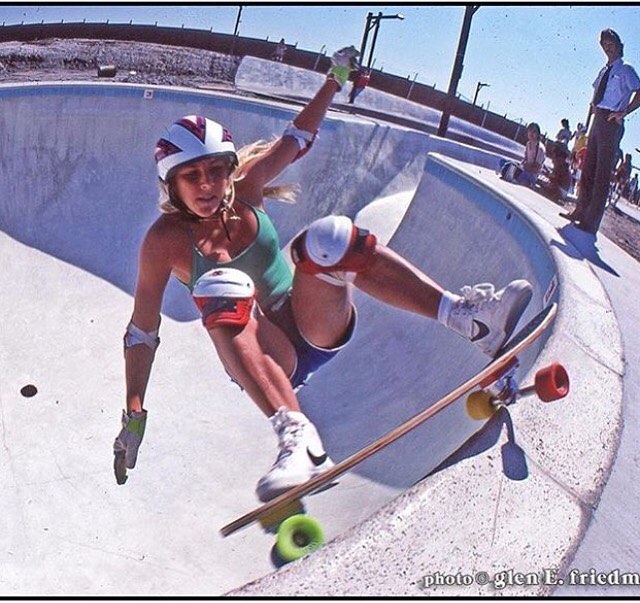
In her “Who’s Hot” article Vicki commended many female skateboarders including Jana Payne, Lori Rarey, and especially Ellen Oneal. And while the experience with Nathan Pratt was irritating, Vickers had positive experiences skating with the likes of Steve Alba, Jay Adams, and Tony Alva. “I love skating with the guys, it makes me more aggressive and helps me a lot in competition” (Goodrich, 1978). The article then ended with an odd statement that reflects the attitude towards women at the time. “Her determination and skill is certainly equal to that of her male counterparts in the sport; and I think most would have to agree that, though she may be quite a lady, she is definitely more than a pretty face.”

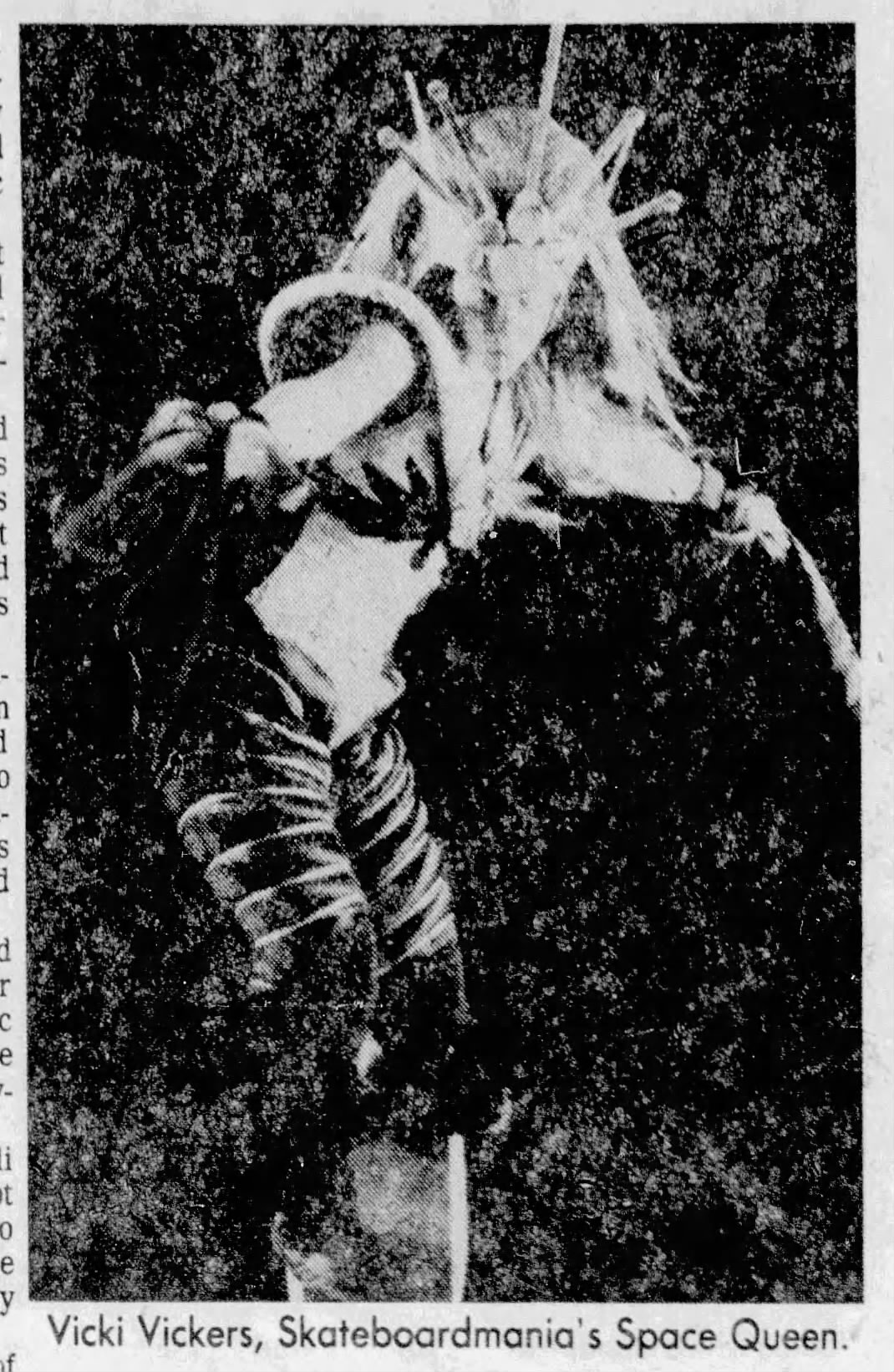
Vicki continued to compete, placing second in the bowl behind Lawrence, and ahead of Wendy Gooding and Rosemary Cortez at the 1978 California Free Former Pro Bank and Bowl contest in November 1978. In April 1979, at the First Annual Gyro Dog Bowl Pro at Marina del Rey Skatepark, Vicki is again bested by Lawrence, coming second out of nine other competitors.

At the second annual Skateboarder Poll featured in the June 1979 issue of Skateboarder, Vicki is voted in as the “Female Skateboarder of the Year.” Vicki also takes the opportunity to join the touring Skateboard Mania show that year with the role of “Space Queen,” which premiered at the Los Angeles Forum.




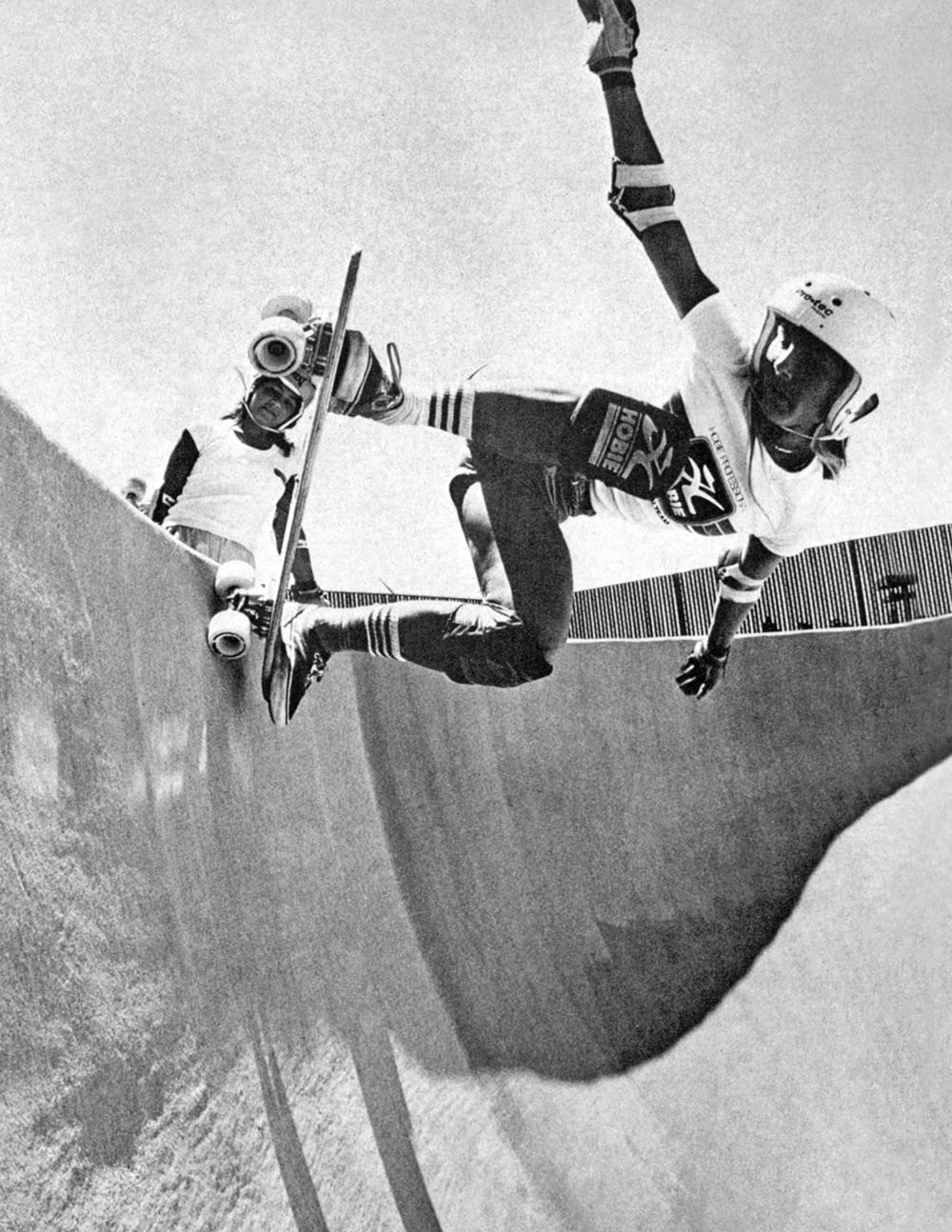
In Vicki’s six-page feature in the December 1979 issue of Skateboarder she really gets into the highs and lows of being a female skateboarder. While she mostly felt accepted, she noted there’s often an assumption when she shows up on tour that she’ll be doing Freestyle until she starts ripping in the pool. Her frustration begins to rise when she shared how the girls’ event is always left to the very end and only run “if we have time,” how people are commenting on “whose shorts are tighter,” and the fact that even though women are professionals they’re not getting paid as much. The girls even had to get to Del Mar at 7 o’clock in the morning for girls’ practice.
The quote that Vicki is most beloved for is when she called out the lack of representation of female skateboarders in the media. She said, “I’ll be damned if we’re not out there breakin’ our necks just like the guys… I mean, I’m pissed! Why can’t I say that – it’s my interview! I want to tell the whole world that we’re being screwed over… I don’t care if there’s no money, there’s always coverage, there’s always the media! How many issues has it been since you’ve seen a girl’s face? About five” (Goodrich, 1979).

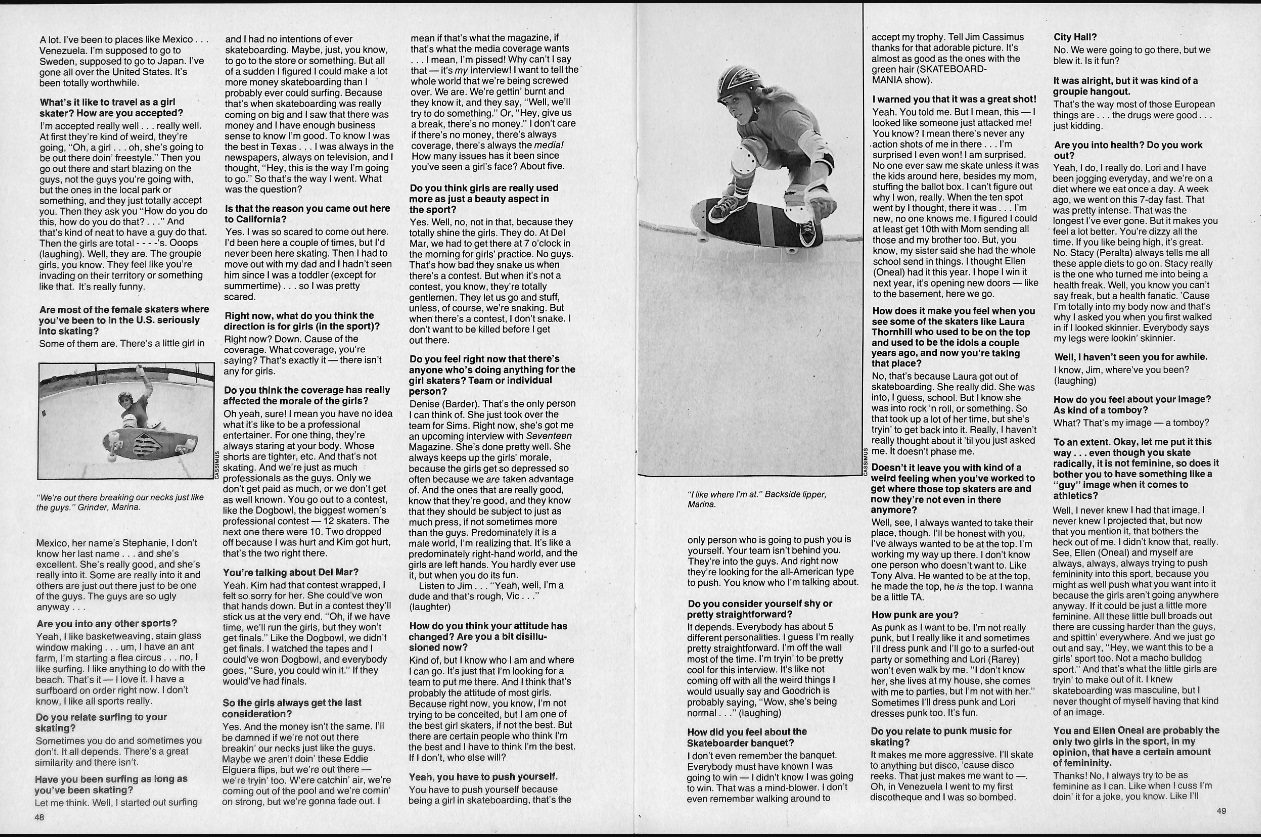

Vicki gave props to the one person who was elevating women in skateboarding at the time, which happened to be another woman (surprise!). It was Denise Barder, the team manager of Sims. “Right now, she’s got me an upcoming interview with Seventeen Magazine. She’s done pretty well. She always keeps up the girls’ morale because the girls get so depressed so often because we are taken advantage of” (Goodrich, 1979).
While there was some awkward discussion on dieting and “femininity” in the interview, rooted in a time-period that was still binary and fixed, Vicki’s message was intended to be encouraging. She said, “You have to push yourself because being a girl in skateboarding, that’s the only person who is going to push you is yourself…” Vicki then acknowledged skateboarders like Brenda Devine, Leilani Kiyabu, Kim Cespedes, Terry Lawrence, her roommate Lori Rarey, and her protégé, up-and-coming skater Canon ‘Bunny’ Price.
In 2002, Vicki was included in Michael Brooke’s book Skate Legends and in 2017 she was inducted into the Skateboarding Hall of Fame, which celebrated how she was one of few women who could do hand-plants, catch air, and hold her own alongside the guys she skated with.
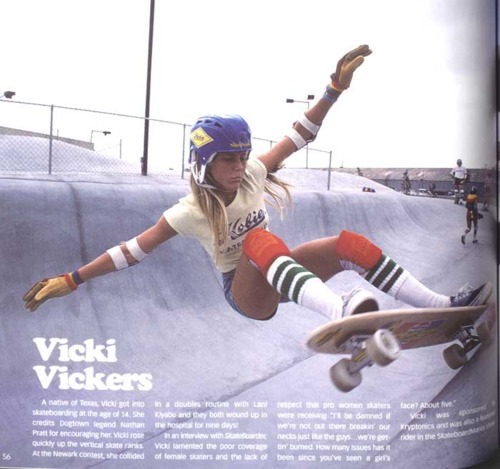

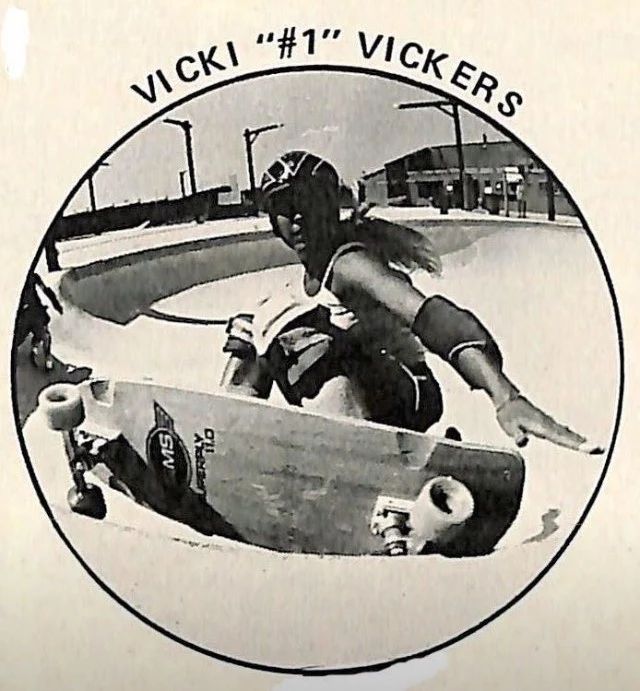

Photos: Anthony Nex, Craig Fineman, Glen E. Friedman, Glenn Miyoda, James Cassimus, Jim Goodrich, Ted Terrebonne
References:
- Brooke, Michael. “Vicki Vickers.” Skate Legends. Toronto, Warwick Publishing, 2002, p. 56.
- Dootson, Di. “Hester’s No. 3 Bowl Contest.” National Skateboarder Review. July 1978.
- Goodrich, Jim. “Vicki Vickers.” Skateboarder. December 1979, pp. 46-51.
- Goodrich, Jim. “Who’s Hot! Vicki Vickers.” Skateboarder. December 1978, pp. 112-113.
- Skateboarding Hall of Fame. Vicki Vickers – 2017.

